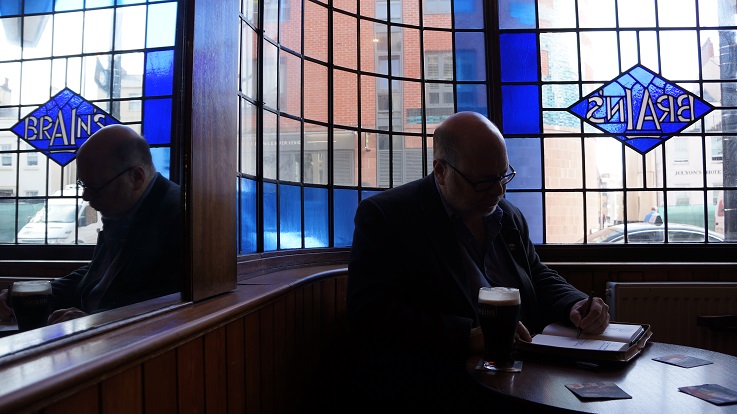 |
77. Esther
When they were refurbishing my motherís apartment, it was obvious that someone dropped her portrait. The painting, by Antonio Gattorno, resided in an antique plaster frame. They rehung the painting on the wall above the couch hoping Esther, my mother, would not notice that the frame was broken, even though pieces of the frame were missing. I noticed immediately when I visited. Worst still, wrinkles had appeared in the canvas, meaning the canvas had shifted on its stretcher. It would have to be re-stretched.Before Ms Keogh, my cherished companion, and I moved to Wales in 2015, we loaned my mother the larger Gattorno painting of his wife Isabel. We bought a new frame for it and hung it above the couch where Estherís portrait formerly hung. Estherís portrait was left on the floor leaning against the wall.
When I had to take Ms Keogh back to the United States for surgery, and her health and my immigration status trapped us there for eight months in 2016-17, I was able to visit with my mother frequently. Since she didnít want it, I took my motherís portrait back to our hotel room.
While it was leaning for many months on the bedroom floor of our hotel room, I began seeing my motherís portrait differently. I never liked it before. It didnít look like any memory I had of my mother. It is her appearance six or seven years before I was born. The artist, with whom my mother had a least a single sexual encounter, had included a symbol in the landscape behind her signifying that she was pregnant, a stork building a nest on the roof of a stone cottage. Gattorno was confident the first born would be a boy, but it was my sister. Although I didnít recognize my mother in the portrait, I did remember the green blouse, which she still had for most of my youth. I was liking the painting more, appreciating the skill that went into it, a classical study in the style of Botticelli. I still didnít want it. Neither did my sister. But I knew my niece would want it.
I went out and bought a flathead screwdriver from the local Rite Aid pharmacy for less than two bucks and with it was able to pry the canvas loose. It was disastrous. I was aghast to discover the state of the canvas. It had become stiff and brittle. Once the matte was removed, I saw a foot long tear along the edge of the canvas where it had been folded over the stretcher. The edges of the canvas crumbled to the touch. Was this typical of a painting more than seventy years old, or was the canvas not properly prepared, or did Gattorno employ canvas of an inferior quality? A metaphor: did it reflect how my views and feeling towards my mother had changed? In childhood, I loved her automatically. She was my mother and I believed in the myths I had created about her. They lingered into my adulthood. I didnít see my mother clearly until my father died and I made a conscious effort to discover who my mother really was? Indeed, she never knew me, never took an interest in what I was doing, didnít even know what I did for a living. She loved me because I was her ďbabyĒ and never understood me as an adult. It is a topic for future essays, but not this one.
The last time I saw my mother was in January, when Ms Keogh and I returned to Philadelphia for Ms Keogh to have yet more surgery. Esther was now living in a nursing home into which she had recently been moved, no longer able to live independently. My sister was there, too, to visit and clean out Estherís apartment. I was able to give her the portrait of our mother, which I had rolled and placed in a tube, and stored in my motherís apartment. My sister took it back to California for her daughter, carrying my warning of the repair it would need.
During a visit to my mother, she said, ďPromise me youíll come back and see me one more time before I die.Ē She always said this each time I left her to return to Wales. She didnít appreciate the reality that any time you say good bye could be the last. I knew when and if I did come back, she would make the same demand of me again. What good, what meaning, did such a promise have?
I have a pessimistic taint inherited from my mother. At departure, I cannot help wondering if I will ever see again the person I am leaving. It is ongoing. I have these thoughts departing from anyone I like if I expect to be away for a length of time. I have these thoughts departing from Ms Keogh even for an hour. And with every essay I write, I wonder, will this be the last essay I will ever write?
I filled Esther with bromides; she never allowed for the truth. I told her I would come back to see her before she died. Not a promise, because I qualified it using the word ďtryĒ. In my heart, I hoped for a good excuse that would prevent me. I am a bad son.
My mother turned ninety-seven earlier this month, 8th February 2018, in the nursing home. Yesterday, I received an email from my sister. ďI had a call from Esther's nurse at Attleboro this morning. (I think her name is Claudia, but I'm not sure). She told me that Esther is refusing to eat and drink and says she'd rather die. She's asking for ĎAmericaní water - she gets thickened water because of her risk of aspiration.Ē This morning, my sister called. Our mother died, 27th February at 04:46 EST. At this time, there are no plans for a memorial service. I live 3,000 miles away in Wales. My sister lives 3,000 miles away in California. The staff of Attleboro Nursing and Rehabilitation Center were with Esther holding her hand at the moment of her death. She will be cremated and the ashes sent to my sister, as my mother had arranged for years ago. אָמֵן ďSo be it.Ē
![]()
Mr Bentzman will continue to report here regularly about
the events and concerns of his life. If you've any
comments or suggestions, he would be pleased to hear from you.
Selected Suburban Soliloquies, the best of Mr Bentzman's earlier series of Snakeskin essays, is available as a book or as an ebook, from Amazon and elsewhere.
